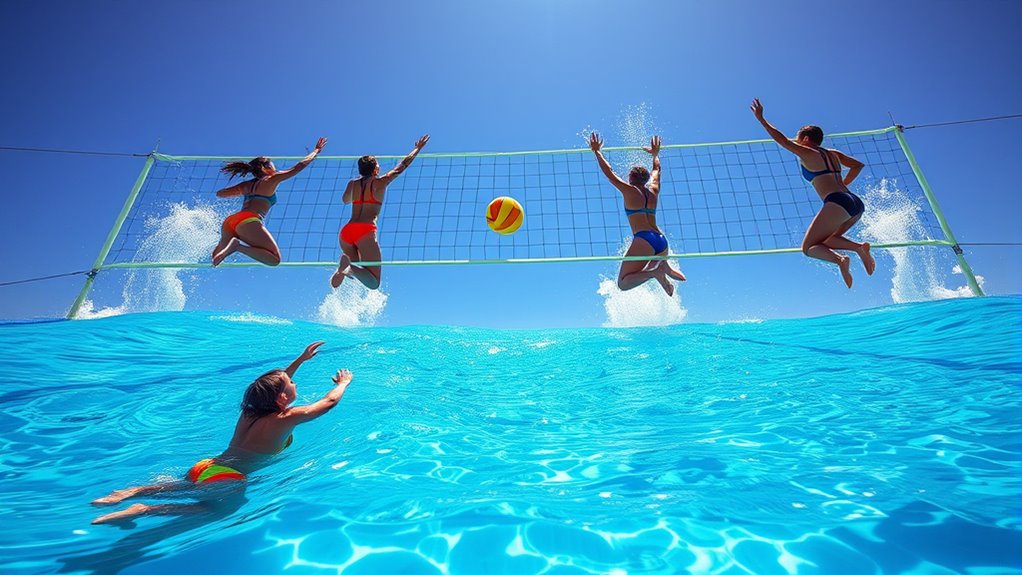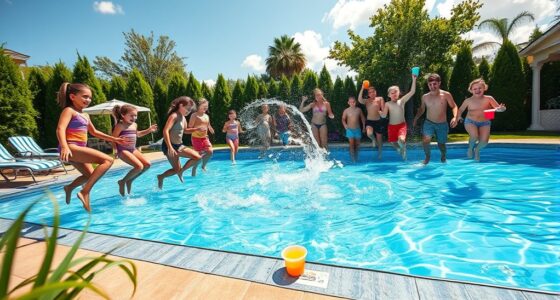To set up water volleyball, choose a calm, flat pool and install a floating, adjustable net at about 7 to 8 feet high. Make sure the area is safe, free of obstacles, and suitable for all skill levels. Play by simple rules similar to traditional volleyball, but always prioritize safety and supervision, especially for beginners. Proper equipment and a secure net enhance the game. Keep exploring to learn more about making your water volleyball experience fun and safe.
Key Takeaways
- Use a standard pool with a secure, adjustable net set at 7-8 feet for optimal gameplay.
- Ensure players are comfortable in water, supervise beginners, and enforce safety rules to prevent injuries.
- Familiarize players with basic rules, including scoring, serving, and rotation, to ensure fair play.
- Maintain a safe, obstacle-free playing area, and use flotation devices if necessary for less confident swimmers.
- Prioritize safety, hydration, and fun to enhance the overall water volleyball experience.

Have you ever wondered how to combine the fun of volleyball with the invigorating challenge of water? Water volleyball is the perfect answer, blending athletic skill with the revitalizing elements of a pool. To truly enjoy this sport, it helps to understand its background and safety considerations. Water volleyball history traces back to the early 20th century, when swimming pools became popular recreational spaces. It evolved from traditional volleyball, adapted for water to reduce impact and increase fun. Today, water volleyball is played worldwide, in both casual and competitive settings, offering a unique twist on the classic game. Knowing its history can deepen your appreciation for the sport, but safety should always be your top priority when playing. Proper hydration and sun protection are also important, especially during outdoor games under the sun. When setting up for water volleyball, the first step is choosing the right location. A standard pool with a flat, calm surface is ideal, providing enough space for players to move freely. Many recreational pools are suitable, but for organized games, a designated water volleyball court with clear boundaries works best. You’ll need a water volleyball net, which is usually a floating, adjustable barrier that spans across the pool. Make sure it’s securely anchored to prevent shifting during play, and set it at a height that’s appropriate for your players—generally around 7 to 8 feet for casual games, but it can vary depending on skill level.
Safety is essential, and water volleyball safety involves several key points. Always ensure players are comfortable in the water before starting. Beginners should be supervised closely, especially if they’re not confident swimmers. It’s wise to establish rules that prevent rough play and accidental injuries—such as no grabbing the net or pushing opponents. Also, keep an eye on the pool’s depth; shallow areas are safer for less experienced swimmers, while deeper zones require more skill. Providing floatation devices or life vests for those who need them adds an extra layer of security. Make sure the playing area is free of obstacles or sharp objects, and encourage players to stay hydrated and take breaks, as water sports can be physically demanding. It’s helpful to familiarize yourself with water sports safety guidelines to ensure a fun and injury-free experience. With a little planning and awareness of water volleyball history and safety, you’re ready to set up an exciting game. Whether you’re playing with friends in a backyard pool or participating in a tournament, understanding the basics will help you enjoy the sport to its fullest. It’s all about balancing fun, skill, and safety, so everyone can have a great time splashing around and rallying over the net. Remember, water volleyball isn’t just a game; it’s an experience that revitalizes both your body and your spirit.
Frequently Asked Questions
What Is the Ideal Pool Size for Water Volleyball?
You should aim for a pool with dimensions around 30 by 60 feet and a water depth of 4 to 6 feet for water volleyball. This size provides enough space for movement and gameplay, ensuring players can jump and dive comfortably. Keep the water depth consistent to maintain safety and fairness. A properly sized pool enhances your experience, making the game fun and engaging for everyone involved.
How Many Players Are Needed for a Game?
Think of water volleyball like a dance; you need enough players to keep the rhythm alive. Typically, six players per team work best, allowing smooth player rotation and flexible team formations. If you have fewer, it’s like missing dancers—your game might stumble. More players can make it lively, but six per team strikes a perfect balance, ensuring everyone stays engaged and the game flows seamlessly.
What Equipment Is Essential Besides the Volleyball?
Besides the volleyball, you need a sturdy net, clearly marked boundary lines, and appropriate pool accessories like floatation devices for water safety. Regular pool maintenance is essential to keep the water clean and safe for everyone. Guarantee the pool’s water quality meets safety standards, and always supervise players to prevent accidents. Using proper equipment and maintaining the pool helps create a fun, safe environment for your water volleyball game.
Can Water Volleyball Be Played With Children?
Yes, you can play water volleyball with children, but guarantee water safety is a priority. Adjust the game to suit their age and skill level, making it easier and less competitive. Encourage child participation by keeping rules simple and providing close supervision. Always monitor their activity closely, and make sure the water is shallow enough for them to stand comfortably. This way, everyone stays safe and enjoys the game.
Are There Official Water Volleyball Tournaments?
Yes, there are official water volleyball tournaments. Like a ripple spreading across a pond, these events showcase competitive water volleyball adhering to official tournament regulations. You’ll find organized competitions at local, national, and even international levels, where players follow strict rules to test their skills. Participating in or watching these tournaments offers a glimpse into the sport’s competitive spirit, proving that water volleyball isn’t just for fun but also for serious athletes.
Conclusion
So, next time you plunge into water volleyball, remember it’s all about fun and staying afloat—literally. You’d think mastering the game would be the challenge, but sometimes, the real skill is simply not laughing when someone splashes you unexpectedly. After all, with all the rules and setup, it’s ironic how the simplest part is just enjoying the splashy chaos. So go ahead, embrace the mess—after all, that’s what makes water volleyball unforgettable.










